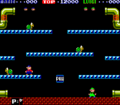NEC PC-88
Template:System-Infobox The PC-8801 was a Zilog Z80-based home computer released by the Nippon Electric Company (NEC) in Japan, in the year 1981. The PC-8801 was informally called the PC-88. It was one of the more popular 8-bit home computers in Japan right next to the MSX and Sharp X1. Some of the companies that produced exclusive software for the NEC PC-88 included Enix, Square, Sega, Nihon Falcom, Bandai, HAL Laboratory, ASCII, Pony Canyon, Technology and Entertainment Software, Wolf Team, Dempa, Champion Soft, Starcraft, Micro Cabin, PSK, and Bothtec. Certain games produced for the PC-88 had a shared release with the MSX, such as those produced by Game Arts, ELF Corporation, and Konami. Many popular series first appeared on the NEC PC-88, including Snatcher, Thexder, Dragon Slayer, RPG Maker, and Ys.
Nintendo licensed Hudson Soft to port some of Nintendo's Family Computer games for the console, including Excitebike, Balloon Fight, Tennis, Golf, and Ice Climber, as well as sequels to Mario Bros. called Mario Bros. Special and Punch Ball Mario Bros., a sequel to Donkey Kong 3 called Donkey Kong 3: Dai Gyakushū, and a unique Super Mario Bros. game for the computer, Super Mario Bros. Special.
Exclusive Mario games released for the NEC PC-88
Mario Bros. Special
- Main article: Mario Bros. Special
Mario Bros. Special was released in 1984. It is not a straight port of Mario Bros., but an original arcade-style platformer with adjustments to the graphics and sounds. There are four different screens. The stages involve Mario figuring out how to progress to the top of the screen, and some levels feature unstable platforms that shake if jumped on.
Punch Ball Mario Bros.
- Main article: Punch Ball Mario Bros.
Punch Ball Mario Bros. was released in 1984. It is very similar to Mario Bros., but with a new object named the Punch Balls that could now be thrown to stun enemies.
Unlike the original game, the floor-level design is almost the exact opposite of the original game. For instance, the first platform above the floor in the original extends from the edges, with a gap in the middle. In this game, the platform is in the middle, with gaps around the edges. Footholds are sturdier and do not trip the enemy if hit from underneath like the first game - only the Punch Balls or POW Blocks could do this now.
The game's artwork, in which Mario is holding a Punch Ball, about to fire.
Donkey Kong 3: Dai Gyakushū
- Main article: Donkey Kong 3: Dai Gyakushū
Donkey Kong 3: Dai Gyakushū was released in October 1984. Like Mario Bros. Special and Punch Ball Mario Bros., the game is not a straight port of Donkey Kong 3 but more of a semi-sequel. The game removes Stanley the Bugman's ability to jump and the need to protect plants, making it much closer to something like Galaga.
Super Mario Bros. Special
- Main article: Super Mario Bros. Special
Super Mario Bros. Special was released in 1986. While superficially very similar to the original Super Mario Bros., the game features original new levels and lacks a screen-scrolling mechanism. When a player reaches the end of a screen, the screen turns blank and loads the next part of the level. Jumping and running physics also differ from the original, providing a much more challenging experience than Super Mario Bros.. Adding more difficulty is the fact that the timer of the level runs much faster than in the NES game, which was already much quicker than the timers in the latest Mario games. Returning was Mario's Hammer from Donkey Kong, alongside a variety of past foes and new exclusive items from the earliest arcade Mario titles, Mario Bros. & Donkey Kong.
Due to the PC88's technology being slightly inferior to that of the NES, the audio and graphics differ slightly from the original NES game as well, although replicated closely. Additionally, the game does not include Luigi or a multiplayer mode.
- List of Super Mario Bros. Special Staff
- Programmed By: Yukio Takeoka
- Courses Designed By: Ichirou Sakurada
- Sound Effects Created By: Fumihiko Itagaki & Megumi Kawamata
- Produced By: Takashi Takebe
External links
- System Information emulation site for retro Japanese computers
- OLD-COMPUTERS.COM: The Museum: NEC PC-88
- NEC PC-88 info page popular games, tags and developers at uvlist.net
- NEC PC-88 MK I comercial on YouTube
- NEC PC-8801 MK II commercial on Youtube
- NEC PC-88 MK II MR comercial on YouTube
- A list of downloadable PC88 emulators
- Strange and Wonderful NEC PC-88 Games (Various games covered, including Mario Bros. Special, Punch Ball Mario Bros. & Super Mario Bros. Special)
- Universal Game List entry for Super Mario Bros. Special
- [1] (a Super Mario Bros. Special walkthrough playlist)
- Universal Video Games List: Punch Ball Mario Bros.




